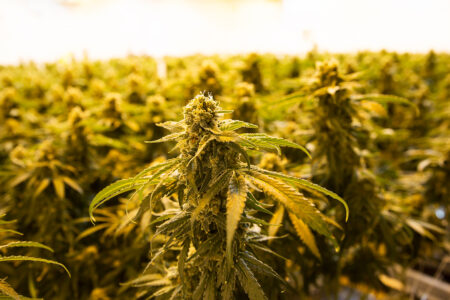
Among the jurisdictions that have legalized cannabis for recreational use in the United States, Oregon has received significant media attention for its booming supply of it. Consumers have enjoyed the resulting low prices: flower is often available for $4 or less per gram, and surveys have indicated an increase in adult use. But suppliers and policy-makers have grown increasingly concerned about the threat that oversupply could prevent one of the primary goals of the legalization effort — the destruction of the black market — from being accomplished. The story behind this turn of events presents a cautionary tale for other jurisdictions looking to create and regulate markets for previously illegal substances.
The economic story of oversupply is straightforward. In normal markets, products are introduced, firms enter and grow, and competition reduces prices. Firms with higher costs are forced out of the marketplace, and prices stabilize into an equilibrium in the long run. Any initial oversupply is corrected during this “shake-out” period. In the cannabis industry, however, the presence of the black market has the potential to disrupt this usual pattern. Firms whose costs exceed the revenues they can get from the prices in the legal market now have the option of diverting their product to the black market. By doing so they ensure both that the prices in the legal market stay low and that the black market thrives.
While concerns about oversupply are not unique to either cannabis as a product or Oregon as a marketplace, Oregon’s situation does appear exceptional. Oregon has more cannabis grow sites and retail locations per capita than other states with legal markets. Its wholesale prices have been significantly more volatile, and retail prices have suffered. This outcome has been shaped by decisions made by state lawmakers during the legalization and regulatory process — a process that resulted in a significantly different system than those of Washington and Colorado, other early legalizers.
Firms whose costs exceed the revenues from prices in the legal market now have the option of diverting their product to the black market, ensuring that prices in the legal market stay low and the black market thrives.
Where Washington and Colorado imposed strict caps on the number of production and retail licences — based on estimates of the amount of cannabis necessary to satisfy the demand within the state — Oregon chose not to limit the number of entrants. Washington and Colorado each implemented severe ownership restrictions: Colorado required retailers and growers to be at least partially vertically integrated (that is, retailers must grow most of the product they sell), while Washington required retailers and growers to be vertically disintegrated (retailers are prohibited from participating in production). Both imposed restraints on multiple-licence ownership. Oregon chose to implement a more permissive licensing system. While the other states restricted investment by individuals living outside their borders, Oregon allowed startup funds to come from anywhere.
The decisions involved in creating this “Wild West” marketplace had some justification: given Oregon’s reputation as being a significant source of black market weed for the rest of the country, lawmakers deliberately designed the regulatory scheme to make it easy to bring those black market producers on board. However, it is this reputation that has made the oversupply problem in Oregon particularly tricky. The US is currently in a state of partial prohibition: only eight states representing approximately a quarter of the US population have chosen to legalize cannabis. Though cannabis for medical use is available in many of the others, rules vary widely, and black markets for the plant and its derivatives thrive across the country. Indeed, some of Oregon’s closest neighbours, Idaho and Utah, currently have no system for legal access to cannabis, medical or recreational.
The threat of diversion from legal markets to illegal markets is not merely theoretical. My colleagues Ben Hansen and Caroline Weber and I have examined sales data from border retailers and identified significant cross-border shopping. Yet this consumer-level diversion is relatively limited compared with the potential for trafficking by licensed producers. Indeed, transporting marijuana a day’s drive away could double its street value, and Oregon-grown cannabis has been found on the opposite coast.
Like other states, Oregon has sought to prevent this sort of large-scale diversion into the black market with a “traceability” system that tracks legal cannabis throughout the supply chain. However, unlike systems implemented by other states, Oregon’s has relatively few controls on the data entered into its database. Oregon has only one data analyst assigned to maintain the system and provide reports for regulatory officials. Consequently, the 23 inspectors responsible for auditing the 1,700 licensees around the state have a difficult job ensuring that the data they receive match the inventory on hand in various greenhouses, warehouses and retailers around the state, let alone identifying malicious intent when discrepancies arise.
Oregon has started to work on addressing these challenges. The state regulator recently imposed a moratorium on new licence applications, citing the need to process the backlog and perform inspections on current licensees. Officials are also preparing requests for additional resources from the state legislature to monitor the market and ensure that all participants comply with the state’s rules. However, it is unlikely that these measures alone will prevent any negative consequences of oversupply. As long as legal market prices in Oregon stay significantly lower than black market prices in other states, growers will have strong incentives to divert at least a portion of their crops. With California choosing to implement a relatively permissive licensing system as well, the supply of cannabis coming from the west coast is only going to increase.
Oregon’s experience, particularly contrasted with the experience of Washington and Colorado, provides a road map to jurisdictions that wish to avoid oversupply. While economists generally oppose restrictions that take the form of burdensome regulations or large fees on entrepreneurs, some degree of constraint — such as fees that scale with the size of the proposed facility and ownership limitations similar to Washington’s — is likely to ensure that the legal market grows at a rate that can be managed by regulators. Neighbouring jurisdictions with significantly different rules may find themselves embroiled in law enforcement and commercial conflicts along the borders, a situation that can be avoided with regional policy agreements and careful assignment of authority and responsibility to local governments. Finally, it is critical to ensure that officials are equipped with the best data possible to regulate the market. Mandatory, comprehensive “seed-to-sale” traceability systems should be implemented, with adequate funding to ensure that the data coming from firms are accurate and usable. Ideally, these systems should include some degree of public access to the data — with appropriate delays to protect trade secrets — to allow for continued research and public accountability. The alternative is a substance market that, like a weed, will grow uncontrollably and in completely unexpected directions.
This article is part of The Economics of Canadian Cannabis special feature.
Photo: Shutterstock, by Lifestyle discover.
Do you have something to say about the article you just read? Be part of the Policy Options discussion, and send in your own submission. Here is a link on how to do it. | Souhaitez-vous réagir à cet article ? Joignez-vous aux débats d’Options politiques et soumettez-nous votre texte en suivant ces directives.







